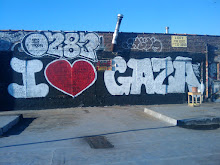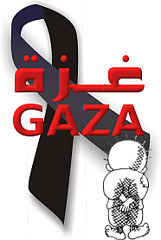Sunday, August 9, 2009
Thursday, August 6, 2009
Kites, Gaza, and the American Ghetto

White phosphorous rockets rain down on Gaza

Gaza youth fly kites on Beit Lahiya beach
Somehow when I first saw the Kite photo, the White Phosphorous photo leapt into my mind. The skies of Gaza went from having lethal plumes of smoke rain down through them, to homemade kites sail up through them. Such is life, with juxtaposing experiences and realities. After being flooded with images of bombs, rockets raining down on Gaza I smiled to see kites sailing, free, up, through the sky. But then I remembered Gaza in 2006-- the image from the beach then imprinted in my mind is of Huda Ghaliya hysterical after an Israeli bomb killed some 7 members of her family who had gone to the beach for the day to escape Israel's bombing campaign.
But this is Gaza-- and I suppose it is similar to other places on earth shackled by war, occupation, colonization, violence, and oppression in its many forms. Every bit of the land holds feelings of love and beauty, history and hope-- but also deep loss, violence, and fear. All these feelings and experiences are interconnected, although some disproportionately realized. As George Santayana observes, "the world is not respectable; it is mortal, tormented, confused, deluded forever; but it is shot through with beauty, with love, with glints of courage and laughter; and in these, the spirit blooms."
Alice Walker recently joined the Code Pink brigade on their mission to Gaza, and wrote poignantly and personally of her experience there. Walker grew up in Georgia during legal segregation in the States and wrote that she felt a "homecoming" upon entering Gaza. The experiences of Black Americans living in segregated Georgia's ghetto find commonality with those of Palestinians imprisoned in Gaza: life defined primarily (solely?) by nationality/race by an outside population; disenfranchisement; fear; movement and freedom limited by tangible physical boundaries; every positive action is one which breathes resistance and struggle. She discusses the pointed effort made by the Civil Rights movement to overcome hatred and work towards a common human spirit. It is this common spirit that somehow eludes our world leaders which we must continue to work towards realizing. Because it is there-- for those who are able, somehow-- surely through personal struggle, self-awareness, and a a deep sense of responsibility-- to rise above the "boxes" we put ourselves in which increase the divisions between us as people, above our own personal loss, the idea of "us" and "them"...the commonalities are evident, and they, hopefully, can lead us in learning to overcome these divisions of hatred which enable the most atrocious forms of violence.
Alice Walker did her part in visiting Gaza and, upon returning to the States and fulfilling a promise she made to a Palestinian woman she'd met during her trip, invited Oprah Winfrey to do the same. Let's see if Oprah's got it in her.
Saturday, August 1, 2009
Gaza Today: August 6, 2009
"The best place one could be on Earth"
(Alice Walker, author of The Color Purple, EI)
(Alice Walker, author of The Color Purple, EI)
(Mel Frykberg, EI)
(Guardian, photos)
(Ian Black, Guardian)
Labels:
activism,
human rights,
mental health,
photos
Thursday, July 9, 2009
Gaza Today: July 9, 2009
(Ali Abunimah, EI-- excellent opinion piece, parts of the speech found here)
(Peter Beaumant et al, Guardian-- video)
(Mel Frykberg, EI)
(al Jazeera English)
(Ben White, Guardian)
(Rami Almeghari, EI)
(Vikram Dodd, Guardian)
Labels:
activism,
aid,
apartheid wall,
gaza,
hamas
Wednesday, June 10, 2009
Gaza Today: June 10, 2009
(Rory McCarthey, Guardian)
(Inigo Gilmore, Guardian, film)
(Inigo Gilmore, Guardian film)
(Human Sciences Research Council, EI)
(Rami Almeghri, EI)
Saturday, June 6, 2009
Gaza Today: June 6, 2009
Obama in Cairo: A Bush in Sheep's Clothes
(Ali Abunimah, Guardian)
(Uri Averny, Maan News)
(Ethan Bronner, NYT)
(Medea Benjamin, EI)
(Peter Beaumont, Guardian)
(Erin Cunningham, EI)
(Sarah Irving, EI)
(Peter Beaumont, Guardian)
(Sousan Hammad, EI)
Labels:
art,
gaza,
Obama,
sanitation,
uri averny
Wednesday, April 29, 2009
"After all this...how can you still laugh?"
Tonight I saw a documentary called "Arna's Children". It was incredibly moving, and like all Palestinian works of art both soulfully uplifting at times and crashingly depressing. But true. Through and through.
It is a documentary about Arna, a Jewish woman born in the late 1920s, early 1930s in Galilee who joins the Jewish Brigade (a Jewish military group which drove out the Palestinians and helped establish Israel) and then marries Salim (?) a Palestinian man. The documentary is fuzzy on her life post marriage, but begins with her as an old woman in Jenin refugee camp in the West Bank, where she opens a theater for Palestinian children. Through art she helps the kids express their anger at their lives and the Israeli Occupation and find a way to resist the Occupation. The film starts around 1996 it seems. Jules, Arna's son and the film maker, returns to Jenin in 2002 after the Israeli incursion to see what has happened to his young friends. As is tragically predictable, Jules finds that three of the young boys Arna taught were martyred during the Intifada-- one killed by the Israelis during the incursion, two (I believe) joined militant groups and died during an operation.
The documentary shows the loss felt by the remaining friends at the death of the young men. It talks candidly about Palestinians' feelings on resistance and militancy. It's an incredibly good window into the complexity of life under Occupation. The experiences of Palestinians under Occupation are not monolithic, nor are the ways in which they process or cope with them. This is quite important to understand-- there is no one, single Palestinian experience, perhaps except that of Occupation...but this is responded to, dealt with, coped with, raged against, mourned in a multitude of ways. "Arna's Children" does really a fantastic job also of, without agenda, exposing the complexity of the history of Palestine. Arna was an Arab Jew who participated in the establishment of Israel, married a Palestinian, and lived her older years in Jenin working with the children of the camp. From that aspect alone, the film was phenomenal to watch. Two of the remaining boys speak of one friend, Yousef, who joined a militant group, and of the event that lead up to his joining it. A school had been bombed and Yousef found a 10 year old girl inside it, bleeding. He picked her up and ran her out, and she died in his arms. His friends say that after that something changed and hardened in him. I've read this before many times. In psychology, your body is able to buffer against stress through certain biological happenings. When your body can no longer buffer against this stress you "break down" in a sense and suffer severe stress or trauma. In literature I've read regarding suicide bombers there is generally one pinpointed event which breaks the person's ability to buffer against the stress of his/her existence, at which point they decide to carry out a violent act. I am not defending suicide bombing-- but it is of value to understand that it is not religious zeal, or insanity which can drive a person to undertake such an act. It's heartwrenching to watch the evolution, but is rooted in life events.
Of course, the film is heart breaking. It is racked with destruction-- emotional, physical, spiritual. The childhood lightness which dominates the first portion of the documentary gives way to an unbearably heavy reality of adulthood in Jenin. All I could think during the film was, what's the point? Helping children enjoy their childhood, fostering dreams within them of becoming the first "Palestinian Romeo" (like one kid says he wants to be) and then they grow up and into a reality which is worse and worse every single day. People respond differently to levels of psychological pressure and distress. Some reach their "breaking point" and are no longer able to, literally, bear the pressure of their life. Others manage to find and retain strength and go on to struggle and live.
There is one incredibly poignant moment in the film when Jules returns to Jenin, and he's speaking with a group of women and tells them he's heard the three boys were martyred. The women respond yes, with blessings for the boys and are so happy to see Jules again after he'd been gone 5 years, they are laughing and hugging him. Jules is so overcome with grief he looks at them and says, "But after all of this...how can you still laugh?" And the women respond, "This is our life!"
Destruction. Death.
That is their life. Interspersed with happiness and beauty, yes. But also with a disproportionate amount of loss.
It reminded me of a friend of mine in college who, also during the Intifada, turned to me and said, "I don't understand how Palestinians can still smile." These issues of resilience, continuity, struggle, they're fascinating and so so so so complex. Often for the sake of brevity and simplicity, we whittle them down to a few examples to represent a myriad of experiences. "Arna's Children" is a wonderful insight into the array of complexities that make up the Palestinian experience. If you have a chance, see it.
Subscribe to:
Comments (Atom)


